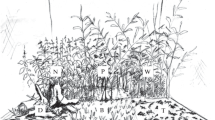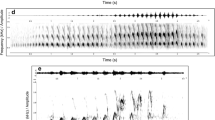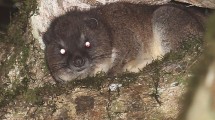Abstract
Field data are presented from a 15-month study of spectral tarsiers in North Sulawesi, Indonesia, based on over 300 sightings of animals in the wild and supplemented by observations from other parts of the island. Animals in study area were caught in mist nets and marked with colored plastic bird rings so that tarsiers followed at night could be individually recognized. Ecological data presented cover the locomotion, use of forest strata, and diet of tarsiers. Although clearly specialized for vertical clinging and leaping, the spectral tarsier is less specialized than the western tarsier, occupying a wider range of habitats and using a wider range of vegetation strata and locomotor patterns. Diet is mostly insects collected both on the ground and in trees. Spectral tarsiers were found to be monogamous and territorial. Families regularly slept at the same sites each day and gave loud duet songs as they congregated at sleeping sites each dawn. Sometimes similar songs were given in the night during territorial conflicts. Family home ranges were plotted and average about 1 ha. Observations are included on mating, the development of young tarsiers, and the dispersion of juveniles. Tarsier young are very precocious and may travel independently as little as 23 days after birth. Tarsiers regularly scent marked their ranges by rubbing branches with urine and special epigastric glands. In addition, they have a varied repertoire of calls and the main vocalizations are described.
Similar content being viewed by others
References
Charles-Dominique, P. (1977).Ecology and Behaviour of Nocturnal Primates, Duckworth, London.
Fogden, M. P. L. (1974). A preliminary field study of the western tarsierTarsius bancanus. Horsfield. In Martin, R. D., Doyle, G. A., and Walker, A. C. (eds.),Prosimian Biology, Duckworth, London.
Fooden, J. (1969). Taxonomy and evolution of the monkeys of Celebes.Bibl. Primatol. 10: 1–148.
Groves, C. P. (1976). The origin of the mammal fauna of Sulawesi (Celebes).Z. f. SÄugetierkunde Bd. 41. H. 4, S. 201–216.
MacKinnon, J., and MacKinnon, K. (1977). The formation of a new gibbon group.Primates 18(3): 701–708.
Niemitz, C. (1972). Puzzle aboutTarsius. Sarawak Mus. J. 20: 329–337.
Niemitz, C. (1974). A contribution to the postnatal behavioral development ofTarsius bancanus, Horsfield, 1821, studied in two cases.Folia Primatol. 21: 250–276.
Niemitz, C. (1979). Outline of the behavior ofTarsius bancanus. In Doyle, G. A., and Martin, R. D. (eds.),The Study of Prosimian Behavior, Academic Press, New York.
Sprankel, H. (1965). Untersuchungen anTarsius, I. Morphologie des Schwanzes nebst ethologischen Bemerkungen.Folia Primatol. 3: 153–188.
Author information
Authors and Affiliations
Rights and permissions
About this article
Cite this article
MacKinnon, J., MacKinnon, K. The behavior of wild spectral tarsiers. Int J Primatol 1, 361–379 (1980). https://doi.org/10.1007/BF02692280
Received:
Revised:
Issue Date:
DOI: https://doi.org/10.1007/BF02692280




